simulate
Monte Carlo simulation of univariate regression model with ARIMA time series errors
Syntax
Description
Y = simulate(Mdl,numobs,Name=Value)simulate returns numeric arrays when all optional input data are
numeric arrays. For example, simulate(Mdl,10,NumPaths=1000,X=Pred)
simulates 1000 sample paths of length 10 from the
regression model with ARIMA errors Mdl, and uses the predictor data in
Pred for the model regression component.
Tbl = simulate(Mdl,numobs,Presample=Presample,PresampleInnovationVariable=PresampleInnovationVariable)Tbl containing a variable for each of
the random paths of response, error model innovation, and unconditional disturbance series
resulting from simulating the regression model with ARIMA errors Mdl.
simulate uses the error model variable
PresampleInnovationVariable in the table or timetable of presample
data Presample to initialize the model. (since R2023b)
To initialize the model using presample unconditional disturbance data, replace the
PresampleInnovationVariable name-value argument with
PresampleRegressionDisturbanceVariable name-value argument.
Tbl = simulate(Mdl,numobs,InSample=InSample,PredictorVariables=PredictorVariables)PredictorVariables in the in-sample table or
timetable of data InSample containing the predictor data for the
model regression component. (since R2023b)
Tbl = simulate(Mdl,numobs,Presample=Presample,PresampleInnovationVariable=PresampleInnovationVariable,InSample=InSample,PredictorVariables=PredictorVariables)
Tbl = simulate(___,Name=Value)
For example,
simulate(Mdl,100,NumPaths=1000,InSample=Tbl,PredictoreVariables="CPI")
returns a timetable containing a variable for each of the response, error model
innovation, and unconditional disturbance series. Each variable is a 100-by-1000 matrix
representing 1000, 100-period paths simulated from the regression model with ARIMA errors.
simulate applies the predictor data in the
CPI variable of the timetable Tbl to the model
regression component.
Examples
Create the following regression model with ARMA(2,1) errors:
where is Gaussian with variance 0.1.
Mdl = regARIMA(Intercept=1,AR={0.5 -0.8},MA=-0.5, ...
Variance=0.1);Mdl is a fully specified regARIMA object.
Simulate a path of responses of length 100.
rng(1,"twister") % For reproducibility y = simulate(Mdl,100);
y is a 100-by-1 vector containing the response path simulated from Mdl.
Plot the simulated path.
plot(y)
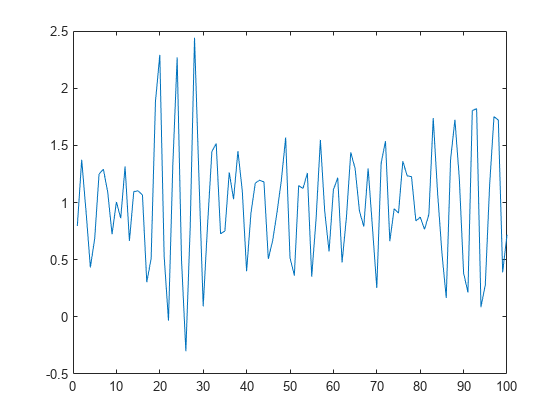
Simulate 1000 paths of responses from the following regression model with ARMA(2,1) errors:
where is Gaussian with variance 0.1. Assume the predictors are standard Gaussian random variables. Provide data as numeric arrays.
Create the regression model with ARIMA errors.
Mdl = regARIMA(Intercept=0,AR={0.5 -0.8},MA=-0.5, ...
Beta=[0.1; -0.2],Variance=0.1);Simulate two series of predictor data for the regression component.
rng(1,"twister") % For reproducibility Pred = randn(100,2);
Simulate 1000 paths of responses each of length 100.
numobs = 100; numpaths = 1000; y = simulate(Mdl,100,X=Pred,NumPaths=1000);
y is a 1000-by-100 matrix containing the independent response paths simulated from Mdl.
Plot the simulated paths.
plot(y)
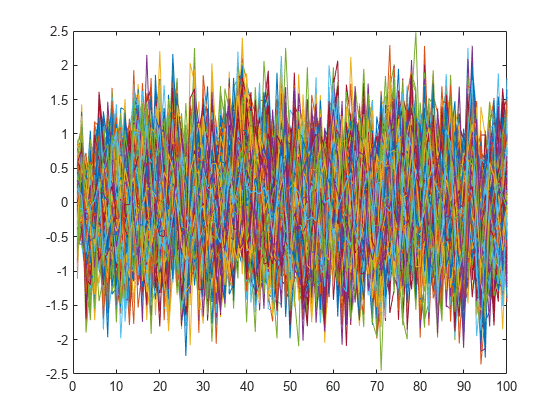
Simulate paths of responses, innovations, and unconditional disturbances from a regression model with SARIMA errors.
Specify the model:
where follows a t-distribution with 15 degrees of freedom.
dstr = struct("Name","t","DoF",15); Mdl = regARIMA(AR={0.2 0.1},MA=0.5,SAR=0.01,SARLags=12, ... SMA=0.02,SMALags=12,D=1,Seasonality=12,Beta=[1.5; -2], ... Intercept=0,Variance=0.1,Distribution=dstr)
Mdl =
regARIMA with properties:
Description: "Regression with ARIMA(2,1,1) Error Model Seasonally Integrated with Seasonal AR(12) and MA(12) (t Distribution)"
SeriesName: "Y"
Distribution: Name = "t", DoF = 15
Intercept: 0
Beta: [1.5 -2]
P: 27
D: 1
Q: 13
AR: {0.2 0.1} at lags [1 2]
SAR: {0.01} at lag [12]
MA: {0.5} at lag [1]
SMA: {0.02} at lag [12]
Seasonality: 12
Variance: 0.1
Simulate and plot 500 paths with 25 observations each.
T = 25; rng(1,"twister") % For reproducibility Pred = randn(T,2); [Y,E,U] = simulate(Mdl,T,NumPaths=500,X=Pred); figure tiledlayout(3,1) nexttile plot(Y) axis tight title("Simulated Response Paths") nexttile plot(E) axis tight title("Simulated Innovations Paths") nexttile plot(U) axis tight title("Simulated Unconditional Disturbances Paths")
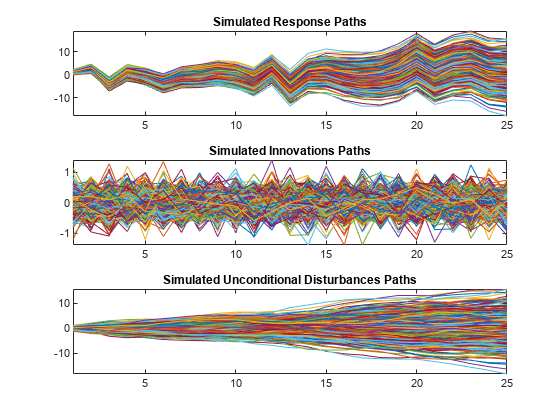
Plot the 2.5th, 50th (median), and 97.5th percentiles of the simulated response paths.
lower = prctile(Y,2.5,2); middle = median(Y,2); upper = prctile(Y,97.5,2); figure plot(1:25,lower,"r:",1:25,middle,"k",1:25,upper,"r:") title("95% Percentile Confidence Interval for Response") legend("95% Interval","Median",Location="best")

Compute statistics across the second dimension (across paths) to summarize the sample paths.
Plot a histogram of the simulated paths at time 20.
figure
histogram(Y(20,:),10)
title("Response Distribution at Time 20")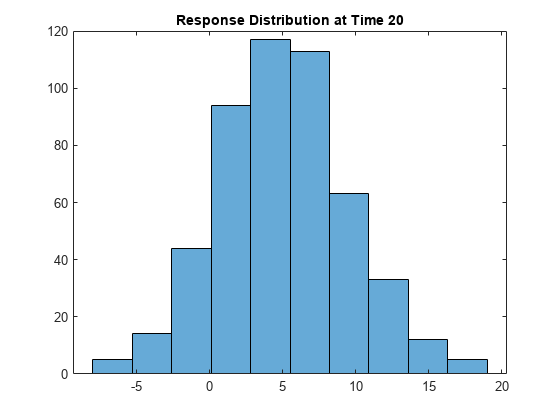
Fit a regression model with ARMA(1,1) errors by regressing the US consumer price index (CPI) quarterly changes onto the US gross domestic product (GDP) growth rate. Forecast log GDP using Monte Carlo simulation and the estimated model. Supply data in timetables.
Load and Transform Data
Load the US macroeconomic data set. Compute the series of GDP quarterly growth rates and CPI quarterly changes.
load Data_USEconModel DTT = price2ret(DataTimeTable,DataVariables="GDP"); DTT.GDPRate = 100*DTT.GDP; DTT.CPIDel = diff(DataTimeTable.CPIAUCSL); T = height(DTT)
T = 248
figure tiledlayout(2,1) nexttile plot(DTT.Time,DTT.GDPRate) title("GDP Rate") ylabel("Percent Growth") nexttile plot(DTT.Time,DTT.CPIDel) title("Index")
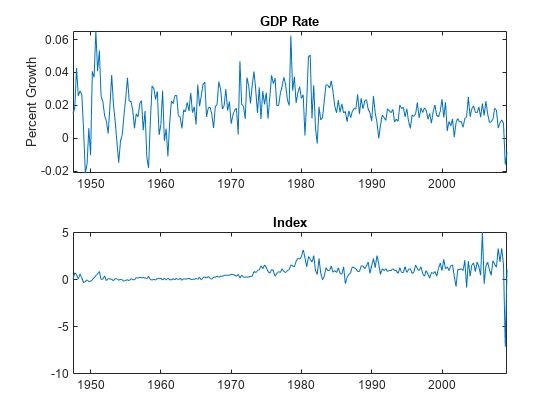
The series appear stationary, albeit heteroscedastic.
Prepare Timetable for Estimation
When you plan to supply a timetable, you must ensure it has all the following characteristics:
The selected response variable is numeric and does not contain any missing values.
The timestamps in the
Timevariable are regular, and they are ascending or descending.
Remove all missing values from the timetable.
DTT = rmmissing(DTT); T_DTT = height(DTT)
T_DTT = 248
Because each sample time has an observation for all variables, rmmissing does not remove any observations.
Determine whether the sampling timestamps have a regular frequency and are sorted.
areTimestampsRegular = isregular(DTT,"quarters")areTimestampsRegular = logical
0
areTimestampsSorted = issorted(DTT.Time)
areTimestampsSorted = logical
1
areTimestampsRegular = 0 indicates that the timestamps of DTT are irregular. areTimestampsSorted = 1 indicates that the timestamps are sorted. Macroeconomic series in this example are timestamped at the end of the month. This quality induces an irregularly measured series.
Remedy the time irregularity by shifting all dates to the first day of the quarter.
dt = DTT.Time; dt = dateshift(dt,"start","quarter"); DTT.Time = dt; areTimestampsRegular = isregular(DTT,"quarters")
areTimestampsRegular = logical
1
DTT is regular.
Create Model Template for Estimation
Suppose that a regression model of the quarterly GDP rate on CPI changes, with ARMA(1,1) errors, is appropriate.
Create a model template for a regression model with ARMA(1,1) errors template. Specify the response variable name.
Mdl = regARIMA(1,0,1);
Mdl.SeriesName = "GDPRate";Mdl is a partially specified regARIMA object.
Partition Data
Reserve 2 years (8 quarters) of data at the end of the series to compare against the forecasts.
numobs = 8; estidx = 1:(T_DTT-numobs); % Estimation sample frstHzn = (T_DTT-numobs+1):T_DTT; % Forecast horizon
Fit Model to Data
Fit a regression model with ARMA(1,1) errors to the estimation sample. Specify the predictor variable name.
EstMdl = estimate(Mdl,DTT(estidx,:),PredictorVariables="CPIDel");
Regression with ARMA(1,1) Error Model (Gaussian Distribution):
Value StandardError TStatistic PValue
__________ _____________ __________ __________
Intercept 0.016489 0.0017307 9.5272 1.6152e-21
AR{1} 0.57835 0.096952 5.9653 2.4415e-09
MA{1} -0.15125 0.11658 -1.2974 0.19449
Beta(1) 0.0025095 0.0014147 1.7738 0.076089
Variance 0.00011319 7.5405e-06 15.01 6.2792e-51
EstMdl is a fully specified, estimated regARIMA object. By default, estimate backcasts for the required Mdl.P = 1 presample regression model residual and sets the required Mdl.Q = 1 presample error model residual to 0.
Forecast Estimated Model
Infer estimation sample unconditional disturbances to initialize the model for forecasting. Specify the predictor variable name.
Tbl0 = infer(EstMdl,DTT(estidx,:),PredictorVariables="CPIDel");Simulate 1000 paths with 8 observations each. Use the inferred unconditional disturbances as presample data. Specify the predictor and presample unconditional disturbance variable names.
rng(1,"twister"); % For reproducibility numpaths = 1000; TblSim = simulate(EstMdl,numobs,NumPaths=numpaths,Presample=Tbl0, ... PresampleRegressionDisturbanceVariable="GDPRate_RegressionResidual", ... InSample=DTT(frstHzn,:),PredictorVariables="CPIDel");
Plot the simulation median forecast and approximate 95% forecast intervals.
TblSim.FStats = quantile(TblSim.GDPRate_Response,[0.025 0.5 0.975],2); figure plot(DTT.Time(end-40:end),DTT.GDPRate(end-40:end),Color=[.7,.7,.7]) hold on h1 = plot(TblSim.Time,TblSim.FStats(:,[1 3]),"r:",LineWidth=2); h2 = plot(TblSim.Time,TblSim.FStats(:,2),"k",LineWidth=2); h = gca; ph = patch([repmat(TblSim.Time(1),1,2) repmat(TblSim.Time(end),1,2)], ... [h.YLim fliplr(h.YLim)], ... [0 0 0 0],"b"); ph.FaceAlpha = 0.1; legend([h1(1) h2],["95% percentile intervals" "Sim. median"],Location="northwest", ... AutoUpdate="off") axis tight title("GDP Rate Forecast Over 2-year Horizon") hold off

Fit a regression model with ARIMA(1,1,1) errors by regressing the quarterly log US GDP onto the log CPI. Forecast log GDP using Monte Carlo simulation and the estimated model. Supply data in timetables.
Load the US macroeconomic data set. Compute the log GDP series.
load Data_USEconModel
DTT = DataTimeTable;
DTT.LogGDP = log(DTT.GDP);
T = height(DTT);Remedy the time irregularity by shifting all dates to the first day of the quarter.
dt = DTT.Time; dt = dateshift(dt,"start","quarter"); DTT.Time = dt;
Reserve 2 years (8 quarters) of data at the end of the series to compare against the forecasts.
numobs = 8; estidx = 1:(T-numobs); % Estimation sample frstHzn = (T-numobs+1):T; % Forecast horizon
Suppose that a regression model of the quarterly log GDP on CPI, with ARMA(1,1) errors, is appropriate.
Create a model template for a regression model with ARMA(1,1) errors template. Specify the response variable name.
Mdl = regARIMA(1,1,1);
Mdl.SeriesName = "LogGDP";The intercept is not identifiable in a regression model with integrated errors. Fix its value before estimation. One way to do this is to estimate the intercept using simple linear regression. Use the estimation sample.
coeff = [ones(T-numobs,1) DTT.CPIAUCSL(estidx)]\DTT.LogGDP(estidx); Mdl.Intercept = coeff(1);
Fit a regression model with ARMA(1,1,1) errors to the estimation sample. Specify the predictor variable name.
EstMdl = estimate(Mdl,DTT(estidx,:),PredictorVariables="CPIAUCSL");
Regression with ARIMA(1,1,1) Error Model (Gaussian Distribution):
Value StandardError TStatistic PValue
__________ _____________ __________ ___________
Intercept 5.8303 0 Inf 0
AR{1} 0.92869 0.028414 32.684 2.6126e-234
MA{1} -0.39063 0.057599 -6.7819 1.1858e-11
Beta(1) 0.0029335 0.0014645 2.0031 0.045166
Variance 0.00010668 6.9256e-06 15.403 1.554e-53
EstMdl is a fully specified, estimated regARIMA object. By default, estimate backcasts for the required Mdl.P = 2 presample regression model residual and sets the required Mdl.Q = 1 presample error model residual to 0.
Infer estimation sample unconditional disturbances to initialize the model for forecasting. Specify the predictor variable name.
Tbl0 = infer(EstMdl,DTT(estidx,:),PredictorVariables="CPIAUCSL");Simulate 1000 paths with 8 observations each. Use the inferred unconditional disturbances as presample data. Specify the predictor and presample unconditional disturbance variable names.
rng(1,"twister"); % For reproducibility numpaths = 1000; TblSim = simulate(EstMdl,numobs,NumPaths=numpaths,Presample=Tbl0, ... PresampleRegressionDisturbanceVariable="LogGDP_RegressionResidual", ... InSample=DTT(frstHzn,:),PredictorVariables="CPIAUCSL");
Plot the simulation median forecast and approximate 95% forecast intervals.
TblSim.FStats = quantile(TblSim.LogGDP_Response,[0.025 0.5 0.975],2); figure plot(DTT.Time(end-40:end),DTT.LogGDP(end-40:end),Color=[.7,.7,.7]) hold on h1 = plot(TblSim.Time,TblSim.FStats(:,[1 3]),"r:",LineWidth=2); h2 = plot(TblSim.Time,TblSim.FStats(:,2),"k",LineWidth=2); h = gca; ph = patch([repmat(TblSim.Time(1),1,2) repmat(TblSim.Time(end),1,2)], ... [h.YLim fliplr(h.YLim)],[0 0 0 0],"b"); ph.FaceAlpha = 0.1; legend([h1(1) h2],["95% percentile intervals" "Sim. median"],Location="northwest", ... AutoUpdate="off") axis tight title("Log GDP Forecast Over 2-year Horizon") hold off
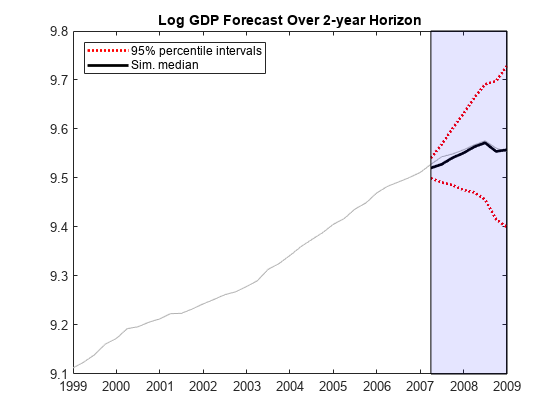
Input Arguments
Sample path length, specified as a positive integer. numobs is
the number of random observations to generate per output path.
Data Types: double
Since R2023b
Presample data containing paths of responses error model innovations
εt or unconditional disturbances
ut to initialize the model, specified as a
table or timetable with numprevars variables and
numpreobs rows.
simulate returns the simulated variables in the output table
or timetable Tbl, which is the same type as
Presample. If Presample is a timetable,
Tbl is a timetable that immediately follows
Presample in time with respect to the sampling frequency.
Each selected variable is a single path (numpreobs-by-1 vector)
or multiple paths (numpreobs-by-numprepaths
matrix) of numpreobs observations representing the presample of
numpreobs observations of error model innovations or unconditional
disturbances.
Each row is a presample observation, and measurements in each row occur
simultaneously. The last row contains the latest presample observation.
numpreobs must be one of the following values:
At least
Mdl.PwhenPresampleprovides only presample unconditional disturbancesAt least
Mdl.QwhenPresampleprovides only presample error model innovationsAt least
max([Mdl.P Mdl.Q])otherwise
If numpreobs exceeds the minimum number,
simulate uses the latest required number of observations
only.
If numprepaths > NumPaths,
simulate uses only the first NumPaths
columns.
If Presample is a timetable, all the following conditions must
be true:
If Presample is a table, the last row contains the latest
presample observation.
By default, simulate sets necessary presample error model
innovations and unconditional disturbances to zero.
If you specify the Presample, you must specify the presample
error model innovation or unconditional disturbance variable name by using the
PresampleInnovationVariable or
PresampleRegressionDisturbanceVariable name-value
argument.
Since R2023b
Error model innovation εt to select from
Presample containing the presample error model innovation data,
specified as one of the following data types:
String scalar or character vector containing the variable name to select from
Presample.Properties.VariableNamesVariable index (positive integer) to select from
Presample.Properties.VariableNamesA logical vector, where
PresampleInnovationVariable(selects variablej) = truejPresample.Properties.VariableNames
The selected variable must be a numeric vector and cannot contain missing values
(NaNs).
If you specify presample error model innovation data by using the
Presample name-value argument, you must specify
PresampleInnovationVariable.
Example: PresampleInnovationVariable="GDP_E"
Example: PresampleInnovationVariable=[false false true false] or
PresampleInnovationVariable=3 selects the third table variable for
presample error model innovation data.
Data Types: double | logical | char | cell | string
Since R2023b
In-sample predictor data for the model regression component, specified as a table or
timetable. InSample contains numvars variables,
including numpreds predictor variables
xt.
simulate returns the simulated variables in the output table
or timetable Tbl, which is commensurate with
InSample.
Each row corresponds to an observation in the simulation horizon, the first row is
the earliest observation, and measurements in each row, among all paths, occur
simultaneously. InSample must have at least
numobs rows to cover the simulation horizon. If you supply more
rows than necessary, simulate uses only the first
numobs rows.
Each selected predictor variable is a numeric vector without missing values
(NaNs). All predictor variables are present in the regression
component of each response equation and apply to all response paths.
If InSample is a timetable, the following conditions apply:
If InSample is a table, the last row contains the latest
observation.
By default, simulate does not include the regression
component in the model, regardless of the value of Mdl.Beta.
Predictor variables xt to select from
InSample containing predictor data for the regression component,
specified as one of the following data types:
String vector or cell vector of character vectors containing
numpredsvariable names inInSample.Properties.VariableNamesA vector of unique indices (positive integers) of variables to select from
InSample.Properties.VariableNamesA logical vector, where
PredictorVariables(selects variablej) = truejInSample.Properties.VariableNames
The selected variables must be numeric vectors and cannot contain missing values
(NaNs).
By default, simulate excludes the regression component,
regardless of its presence in Mdl.
Example: PredictorVariables=["M1SL" "TB3MS"
"UNRATE"]
Example: PredictorVariables=[true false true false] or
PredictorVariable=[1 3] selects the first and third table variables
to supply the predictor data.
Data Types: double | logical | char | cell | string
Name-Value Arguments
Specify optional pairs of arguments as
Name1=Value1,...,NameN=ValueN, where Name is
the argument name and Value is the corresponding value.
Name-value arguments must appear after other arguments, but the order of the
pairs does not matter.
Before R2021a, use commas to separate each name and value, and enclose
Name in quotes.
Example:
simulate(Mdl,100,NumPaths=1000,InSample=Tbl,PredictoreVariables="CPI")
returns a timetable containing a variable for each of the response, error model innovation,
and unconditional disturbance series. Each variable is a 100-by-1000 matrix representing
1000, 100-period paths simulated from the regression model with ARIMA errors.
simulate applies the predictor data in the CPI
variable of the timetable Tbl to the model regression
component.
Number of independent sample paths to generate, specified as a positive integer.
Example: NumPaths=1000
Data Types: double
Predictor data for the model regression component, specified as a numeric matrix
containing numpreds columns. numpreds is the
number of predictor variables (numel(Mdl.Beta)). Use
X only when you supply optional data inputs as numeric
arrays.
Each row of X corresponds to a period in the length
numobs simulation sample (period for which
simulate simulates observations; the period after the
presample). X must have at least numobs rows.
The last row contains the latest predictor data. If X has more than
numobs rows, simulate uses only the
latest numobs rows.
simulate does not use the regression component in the
presample period.
Each column is an individual predictor variable.
simulate applies X to each path; that
is, X represents one path of observed predictors.
By default, simulate excludes the regression component,
regardless of its presence in Mdl.
Data Types: double
Presample error model innovations εt
used to initialize the moving average (MA) component of the error model, specified as
a numpreobs-by-1 numeric column vector or a
numpreobs-by-numprepaths matrix. Use
E0 only when you supply optional data inputs as numeric
arrays.
numpreobs is the number of presample observations.
numprepaths is the number of presample response paths.
Each row is a presample observation (sampling time), and measurements in each row
occur simultaneously. The last row contains the latest presample observation.
numpreobs must be at least Mdl.Q to initialize
the MA component. If numpreobs is larger than required,
simulate uses the latest required number of observations
only.
Columns of E0 are separate, independent presample paths. The
following conditions apply:
If
E0is a column vector, it represents a single residual path.simulateapplies it to each output path.If
E0is a matrix,simulateappliesE0(:,to initialize simulating pathj)j.E0must have at leastNumPathscolumns;simulateuses only the firstNumPathscolumns ofE0.
Data Types: double
Presample unconditional disturbances ut
used to initialize the autoregressive (AR) component of the error model, specified as
a numpreobs-by-1 numeric column vector or a
numpreobs-by-numprepaths matrix. Use
U0 only when you supply optional data inputs as numeric
arrays.
Each row is a presample observation (sampling time), and measurements in each row
occur simultaneously. The last row contains the latest presample observation.
numpreobs must be at least Mdl.P to initialize
the AR component. If numpreobs is larger than required,
simulate uses the latest required number of observations
only.
Columns of U0 are separate, independent presample paths. The
following conditions apply:
If
U0is a column vector, it represents a single residual path.simulateapplies it to each output path.If
U0is a matrix,simulateappliesU0(:,to initialize simulating pathj)j.U0must have at leastNumPathscolumns;simulateuses only the firstNumPathscolumns ofU0.
Data Types: double
Since R2023b
Unconditional disturbance variable ut to
select from Presample containing data for the presample
unconditional disturbances, specified as one of the following data types:
String scalar or character vector containing a variable name in
Presample.Properties.VariableNamesVariable index (positive integer) to select from
Presample.Properties.VariableNamesA logical vector, where
PresampleRegressionDistrubanceVariable(selects variablej) = truejPresample.Properties.VariableNames
The selected variable must be a numeric vector and cannot contain missing values
(NaNs).
If you specify presample unconditional disturbance data by using the
Presample name-value argument, you must specify
PresampleRegressionDistrubanceVariable.
Example: PresampleRegressionDistrubanceVariable="StockRateU"
Example: PresampleRegressionDistrubanceVariable=[false false true
false] or PresampleRegressionDistrubanceVariable=3
selects the third table variable as the presample unconditional disturbance
data.
Data Types: double | logical | char | cell | string
Note
NaNvalues inX,E0, andU0indicate missing values.simulateremoves missing values from specified data by list-wise deletion.For the presample,
simulatehorizontally concatenates the possibly jagged arraysE0andU0with respect to the last rows, and then it removes any row of the concatenated matrix containing at least oneNaN.For in-sample data,
simulateremoves any row ofXcontaining at least oneNaN.
This type of data reduction reduces the effective sample size and can create an irregular time series.
For numeric data inputs,
simulateassumes that you synchronize the presample data such that the latest observations occur simultaneously.simulateissues an error when any table or timetable input contains missing values.
Output Arguments
Simulated response paths yt, returned as a numobs-by-1 numeric column vector or a numobs-by-NumPaths numeric matrix. simulate returns Y by default and when you supply optional data in numeric arrays.
Y represents the continuation of the presample responses in Y0.
Each row corresponds to a period in the simulated series; the simulated series has the periodicity of Mdl. Each column is a separate simulated path.
Simulated error model innovations paths
εt, returned as a
numobs-by-1 numeric column vector or a
numobs-by-NumPaths numeric matrix. Each
column (path) of E has a mean of zero.
simulate returns E by default and when
you supply optional data in numeric arrays
The dimensions of E correspond to the dimensions of
Y.
Since R2023b
Simulated response yt, error model
innovation εt, and unconditional disturbance
ut paths, returned as a table or
timetable, the same data type as Presample or
InSample. simulate returns
Tbl only when you supply at least one of the inputs
Presample and InSample.
Tbl contains the following variables:
The simulated response paths, which are in a
numobs-by-NumPathsnumeric matrix, with rows representing observations and columns representing independent paths. Each path represents the continuation of the presample inPresample, or each path corresponds, in time, with the rows ofInSample.simulatenames the simulated response variable inTblresponseName_ResponseresponseNameMdl.SeriesName. For example, ifMdl.SeriesNameisGDP,Tblcontains a variable for the corresponding simulated response paths with the nameGDP_Response.The simulated error model innovation paths, which are in a
numobs-by-NumPathsnumeric matrix, with rows representing observations and columns representing independent paths. Each path has a mean of zero, and represents the continuation of the corresponding presample path inPresample, or each path corresponds, in time, with the rows ofInSample.simulatenames the simulated error model innovation variable inTblresponseName_ErrorInnovationresponseNameMdl.SeriesName. For example, ifMdl.SeriesNameisGDP,Tblcontains a variable for the corresponding simulated error model innovation paths with the nameGDP_ErrorInnovation.The simulated unconditional disturbance paths, which are in a
numobs-by-NumPathsnumeric matrix, with rows representing observations and columns representing independent paths. Each path represents the continuation of the corresponding presample path inPresample, or each path corresponds, in time, with the rows ofInSample.simulatenames the simulated unconditional disturbance variable inTblresponseName_RegressionInnovationresponseNameMdl.SeriesName. For example, ifMdl.SeriesNameisGDP,Tblcontains a variable for the corresponding simulated unconditional disturbance paths with the nameGDP_RegressionInnovation.When you supply
InSample,Tblcontains all variables inInSample.
If Tbl is a timetable, the following conditions hold:
The row order of
Tbl, either ascending or descending, matches the row order ofPreample.If you specify
InSample, row timesTbl.TimeareInSample.Time(1:numobs). Otherwise,Tbl.Time(1)is the next time afterPresample(end)relative to the sampling frequency, andTbl.Time(2:numobs)are the following times relative to the sampling frequency.
References
[1] Box, George E. P., Gwilym M. Jenkins, and Gregory C. Reinsel. Time Series Analysis: Forecasting and Control. 3rd ed. Englewood Cliffs, NJ: Prentice Hall, 1994.
[2] Davidson, R., and J. G. MacKinnon. Econometric Theory and Methods. Oxford, UK: Oxford University Press, 2004.
[3] Enders, Walter. Applied Econometric Time Series. Hoboken, NJ: John Wiley & Sons, Inc., 1995.
[4] Hamilton, James D. Time Series Analysis. Princeton, NJ: Princeton University Press, 1994.
[5] Pankratz, A. Forecasting with Dynamic Regression Models. John Wiley & Sons, Inc., 1991.
[6] Tsay, R. S. Analysis of Financial Time Series. 2nd ed. Hoboken, NJ: John Wiley & Sons, Inc., 2005.
Version History
Introduced in R2013bIn addition to accepting presample and in-sample predictor data in numeric arrays,
simulate accepts input data in tables or regular timetables. When
you supply input data in a table or timetable, the following conditions apply:
If you specify optional presample error model innovation or unconditional disturbance data to initialize the model, you must also specify corresponding variable names containing the data to use.
If you specify optional in-sample predictor data for the model regression component, you must also specify corresponding predictor variable names containing the data to use.
simulatereturns results in a table or timetable.
Name-value arguments to support tabular workflows include:
InSamplespecifies the table or regular timetable of predictor data for the model regression component.PredictorVariablesspecifies the names of the predictor series to select fromInSamplefor the model regression component.Presamplespecifies the input table or timetable of presample regression innovation or error model innovation data.PresampleInnovationVariablespecifies the name of the error model innovation series to select fromPresample.PresampleRegressionDisturbanceVariablespecifies the name of the unconditional disturbance series to select fromPresample.
See Also
Objects
Functions
Topics
- Alternative ARIMA Model Representations
- Simulate Stationary Processes
- Simulate Trend-Stationary and Difference-Stationary Processes
- Monte Carlo Simulation of Conditional Mean Models
- Presample Data for Conditional Mean Model Simulation
- Transient Effects in Conditional Mean Model Simulations
- Monte Carlo Forecasting of Conditional Mean Models
MATLAB Command
You clicked a link that corresponds to this MATLAB command:
Run the command by entering it in the MATLAB Command Window. Web browsers do not support MATLAB commands.
选择网站
选择网站以获取翻译的可用内容,以及查看当地活动和优惠。根据您的位置,我们建议您选择:。
您也可以从以下列表中选择网站:
如何获得最佳网站性能
选择中国网站(中文或英文)以获得最佳网站性能。其他 MathWorks 国家/地区网站并未针对您所在位置的访问进行优化。
美洲
- América Latina (Español)
- Canada (English)
- United States (English)
欧洲
- Belgium (English)
- Denmark (English)
- Deutschland (Deutsch)
- España (Español)
- Finland (English)
- France (Français)
- Ireland (English)
- Italia (Italiano)
- Luxembourg (English)
- Netherlands (English)
- Norway (English)
- Österreich (Deutsch)
- Portugal (English)
- Sweden (English)
- Switzerland
- United Kingdom (English)